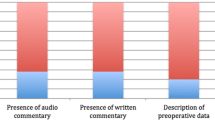Abstract
Background
The aim of this study is to evaluate the quality of the most commonly viewed total extraperitoneal laparoscopic inguinal hernia repair (TEP) videos on Youtube, which is the largest social and medical media broadcasting service, concerning educational purposes.
Method
A search with the keyword “total extraperitoneal laparoscopic inguinal hernia repair” was performed on Youtube. The first 120 videos among the search results were downloaded and 55 of them were included in the study. A scoring system developed by the authors according to the recent literature was utilized for evaluation of the videos. Video demographics were evaluated for the quality and upload source.
Results
Among the enrolled videos, video quality was rated as good in 13 (23.6%), as moderate in 22 (40%), and as poor in 20 (36.4%). Video length, presence of narration, number of likes, and comments were significantly higher in the good group. Upload source was an academic center in 14 (25.5%), a community hospital in 22 (40.0%), and a physician in 19 (34.5%). The mean video score of the academic center group (8 ± 4.095) and community hospital group (8.64 ± 3.259) was significantly higher than the physician group (5.47 ± 2.632) (p = 0.010). Video quality was not correlated with total views or views per day.
Conclusion
Total extraperitoneal laparoscopic inguinal hernia repair procedure videos uploaded to Youtube demonstrate considerable heterogeneity in terms of educational quality and the number of good quality videos is significantly low. This heterogeneity is attributed to the lack of peer review process for the evaluation of educational quality of the videos. Therefore, a physician intending to learn and practice a surgical procedure properly (TEP repair in this situation) should not consider a broadcasting service without a peer review process as a reliable training source.
Similar content being viewed by others
References
Stein S, Stulberg J, Champagne B (2012) Learning laparoscopic colectomy during colorectal residency: what does it take and how are we doing? Surg Endosc 26(2):488–492
Bass BL (2006) Matching training to practice: the next step. Ann Surg 243(4):436–438
Pugh CM, Darosa DA, Bell RH Jr (2010) Residents' self-reported learning needs for intraoperative knowledge: are we missing the bar? Am J Surg 199(4):562–565
The Royal College of Surgeons of England, I.W.T.R.T. (2014) The ımplementation of the working time directive, and ıts impact on the NHS and health professionals. The Royal College of Surgeons of England, London
Accreditation Council for Graduate Medical Education (2019) Common Program Requirements (Residency). https://www.acgme.org/Portals/0/PFAssets/ProgramRequirements/140_InternalMedicine_2019.pdf
Gurusamy KS et al (2009) Virtual reality training for surgical trainees in laparoscopic surgery. Cochrane Database Syst Rev. https://doi.org/10.1002/14651858.CD006575.pub2
Scott DJ et al (2000) Laparoscopic training on bench models: better and more cost effective than operating room experience? J Am Coll Surg 191(3):272–283
Samia H et al (2013) Simulation and its role in training. Clin Colon Rectal Surg 26(1):47–55
Carter J, Duh QY (2011) Laparoscopic repair of inguinal hernias. World J Surg 35(7):1519–1525
Rapp AK et al (2016) YouTube is the most frequently used educational video source for surgical preparation. J Surg Educ 73(6):1072–1076
iProspect Search Engine User Behaviour Study (2006). http://district4.extension.ifas.ufl.edu/Tech/TechPubs/WhitePaper_2006_SearchEngineUserBehavior.pdf
Esen E et al (2019) YouTube english videos as a source of information on breast self-examination. Breast Cancer Res Treat 173(3):629–635
Singh AG, Singh S, Singh PP (2012) YouTube for information on rheumatoid arthritis–a wakeup call? J Rheumatol 39(5):899–903
Bittner R et al (2011) Guidelines for laparoscopic (TAPP) and endoscopic (TEP) treatment of inguinal hernia [International Endohernia Society (IEHS)]. Surg Endosc 25(9):2773–2843
Simons MP et al (2009) European Hernia Society guidelines on the treatment of inguinal hernia in adult patients. Hernia 13(4):343–403
McKernan JB, Laws HL (1993) Laparoscopic repair of inguinal hernias using a totally extraperitoneal prosthetic approach. Surg Endosc 7(1):26–28
Bittner R et al (2015) Update of guidelines on laparoscopic (TAPP) and endoscopic (TEP) treatment of inguinal hernia (International Endohernia Society). Surg Endosc 29(2):289–321
Statistics (2018) Statistics. https://www.youtube.com/intl/en-GB/about/press/. Accessed 21 Sept 2018
Celentano V et al (2018) Use of laparoscopic videos amongst surgical trainees in the United Kingdom. Surgeon 17:334
Rodriguez HA et al (2018) Viewer discretion advised: is YouTube a friend or foe in surgical education? Surg Endosc 32(4):1724–1728
Madathil KC et al (2015) Healthcare information on YouTube: a systematic review. Health Inform J 21(3):173–194
Frongia G et al (2016) YouTube as a potential training resource for laparoscopic fundoplication. J Surg Educ 73(6):1066–1071
Lee JS, Seo HS, Hong TH (2015) YouTube as a potential training method for laparoscopic cholecystectomy. Ann Surg Treat Res 89(2):92–97
Smith CD (1999) Laparoscopic totally extraperitoneal inguinal hernia repair. Oper Tech General Surg 1(2):185–196
Celentano V et al (2018) LAP-VEGaS practice guidelines for reporting of educational videos in laparoscopic surgery: a joint trainers and trainees consensus statement. Ann Surg 268(6):920–926
Funding
There is no funding information in this paper.
Author information
Authors and Affiliations
Corresponding author
Ethics declarations
Disclosures
Betül Keskinkılıç Yağız, Metin Yalaza, and Ali Sapmaz have no conflicts of interest or financial ties to disclose.
Additional information
Publisher's Note
Springer Nature remains neutral with regard to jurisdictional claims in published maps and institutional affiliations.
Rights and permissions
About this article
Cite this article
Keskinkılıç Yağız, B., Yalaza, M. & Sapmaz, A. Is Youtube a potential training source for total extraperitoneal laparoscopic inguinal hernia repair?. Surg Endosc 35, 2014–2020 (2021). https://doi.org/10.1007/s00464-020-07596-3
Received:
Accepted:
Published:
Issue Date:
DOI: https://doi.org/10.1007/s00464-020-07596-3




